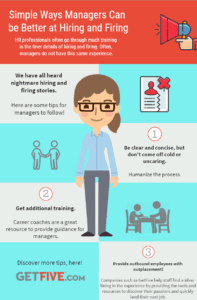
We’ve all heard nightmarish hiring-and-firing stories that unfortunately seem all too common.
- There are the applicants who take the time to go through three or four rounds of interviews, and then never hear a peep. They don’t even get the common courtesy of an email or phone call alerting them they are no longer being considered.
- It’s the people who have been with companies for decades, only to come to work one day to an empty desk, cold shoulder from employees and a boss with vague answers. It seems they’ve been deemed redundant or are being replaced by a younger (likely lower-cost) employee.
- It’s the people who learn they are getting let go in the most awful ways, from prerecorded phone messages to emails disrupting them while on vacation. There was absolutely no compassion in how this life-changing message was delivered.
HR professionals often go through much training in the finer details of hiring and firing. Managers do not typically have this same experience.
Even tenured executives struggle with these often difficult tasks, which leaves plentiful room for error. A genius in the boardroom may be awful when it comes to onboarding and offboarding correctly.
Letting someone go is particularly difficult. In tough times, it’s important to be clear and concise with your communication, but you also need to avoid coming off as cold and uncaring. You’re speaking to someone who has invested much time with the organization, and it’s very possible this news is catching them off-guard. You must be able to look them in the eye, tell them the news and show empathy. Bottom line: You must humanize the process.
This doesn’t come naturally to most people and certainly won’t for managers who didn’t get any type of formal training in doing so. When your days are focused on processes, productivity, and profit, managing the complex logistics of hiring and firing is overwhelming. It’s no surprise that mistakes are made so frequently, but that’s no excuse.
One way to solve this lack of skill set is for managers to get additional training. A career coach is a wonderful resource for working through these sorts of professional developmental hurdles. These experts are able to provide guidance, work through proven exercises, and give the necessary resources for you to thrive. For people in the C-suite, executive coaching is an absolute must. It’s your ace in the hole.
Once you have the education and a support system in place, anyone can excel at their jobs, even when they must do difficult tasks like firing staff. In addition to humanizing the process, you’ll know about tools like GetFive outplacement services that help staff find a silver lining from the experience. These services provide ex-employees the tools they need to discover their passion and find their next job faster.
It’s important that people have a positive experience with your company, no matter how long or short that experience is. It might be the candidate who interviewed but didn’t get hired. It might be the employee who worked there for 15 years, but is now getting laid off. Managers must prioritize this, and if they need some extra help, education and support are close by.









